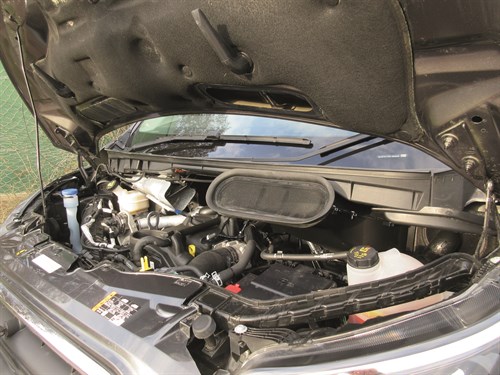- ETRUX receives Ford Pro Convertor status
- The Logistics Organisation adds to van fleet with Vanaways
- Northgate launches micromobility service
- Progress being made on shared EV charging, AFP reports
- Medisort electrifying van fleet with Bedeo
- ADVERTISEMENT FEATURE: Taking a shortcut to reduce commercial vehicle emissions
- The What Van? Road Test: Ford Ranger Raptor
- Speakers announced for Commercial Vehicle Show
- Check new vehicle registration details are correct, AFP tells fleets
- New Market Analysis: Large Vans
The What Van? Road Test: Ford Transit (2020)
Date: Wednesday, September 1, 2021

Powertrain
Featuring common rail direct fuel injection, Transit’s turbocharged 16-valve four-cylinder in-line diesel produces maximum power output at 3500rpm. Maximum torque of 390Nm bites across a handily-broad 1750–2500rpm plateau.
Diesel Transits make use of a diesel particulate filter and Selective Catalytic Reduction to meet the Euro 6 exhaust emission standard, and SCR relies on AdBlue. The top-up point that feeds the 21-litre reservoir is beneath a flap close to the passenger door along with the capless Easy-Fuel diesel filler point.
Driving
Our Transit handled remarkably well, clinging determinedly to the highway as we pushed it hard through bend after bend and showing no inclination to come unstuck.
The presence of curve control undoubtedly helped. It is there to make sure you stay in control of your vehicle if you take a bend too rapidly. If it detects under-steer and suspects everything is about to go pear-shaped then it reduces engine torque and applies the brakes to help bring your speed down.
Nor was the Transit short on performance, although there were one or two occasions when we felt the automatic transmission’s kick-down facility could have been a bit more aggressive.
Otherwise, the auto box was a treat, nipping briskly and smoothly from one gear to the next without a hint of jerkiness.
It was biddable during low-speed manoeuvring too. At no point did it cause the van to jolt suddenly or hurtle forwards unexpectedly.
If you feel you want to then you can push the transmission lever to M for Manual, then flick a switch on the side of the lever every time you want to go up and down the box. It’s an easy enough system to use, but we suspect most drivers will leave the box in its automatic setting for the majority of the time and let it get on with things.
Drawbacks
Ford needs to pay more attention to managing in-cab noise levels, especially so far as the engine and transmission are concerned. Wind noise was an issue too, and we were concerned about the level of vibration at tick-over.
Build quality needs tightening a little to match the – admittedly extraordinarily high – standards set by the Crafter and Sprinter.
While our test Transit rode well, there was a bit too much thumping and bumping from the suspension even on smooth road surfaces.
Resorting to the Eco setting on the mode switch should help keep diesel consumption down. Pressing it modifies the Transit’s torque setting and rate of acceleration among other functions. As a consequence, fuel usage should fall by approximately 10% says Ford.
The switch’s Slippery option changes the electronic stability control and traction control settings to provide enhanced grip in several weather conditions, such as ice, snow and mud.
View The WhatVan Digital Edition


